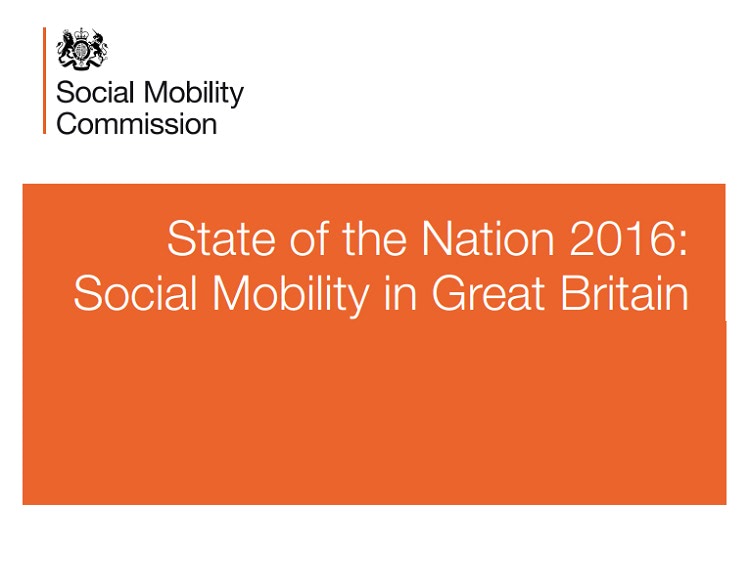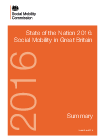Social Mobility in the UK: State of the Nation, the 2016 Report

The fourth annual ‘State of the nation’ report from the Social Mobility Commission. This report assesses the progress that Great Britain has made towards improving social mobility.
The Social Mobility Commission is currently chaired by ex-Labour MP, Alan Milburn.
On education, the Commission concluded that there was an: “Entrenched and unbroken correlation between social class and educational success“.
Repeated attempts to reform the education system have not produced a big enough social mobility dividend.
Key findings included:
- In the last decade 500,000 poorer children were not school-ready by age five
- Poorer children, who stand to gain most from high-quality childcare, are least likely to receive it
- Just 5 per cent of children eligible for free school meals gain 5 A grades at GCSE
- A child living in one of England’s most disadvantaged areas is 27 times more likely to go to an inadequate school than a child living in one of the least disadvantaged.
- Funding is being diverted from second chance education in further education (FE) colleges to apprenticeships, which are often of low quality, in low-skill sectors and not linked to the country’s skill gaps.
- Despite recent progress, for every child who goes to university from a family in the bottom two income quintiles, seven do not.
- Youngsters cannot access higher education (HE) locally in many parts of the country
The report’s recommendations on education include:
In the early years
- Introduction of new parental support package to support children falling behind.
- A new target for every child to be ‘school ready’ by age 5, by 2025.
- Double funding for the early years pupil premium (currently this is worth around £300 per annum).
At school level:
- Rethink the plans for more grammar schools and academies.
- Set as the core mission reducing the attainment gap at GCSE by two thirds, within the next decade.
- Mandate the ten lowest-performing local authorities to participate in improvement programmes. • Reform systems of teacher training and teacher distribution, and offer new incentives and better starting pay.
- Require independent schools and universities to provide careers advice and other support.
- “re-purpose” the National Citizen Service to offer work experience or extra-curricular activity.
In further and higher education:
- The development of a single UCAS-style portal over the next 4 years to help young people with choices about life after school.
- Making schools more accountable for the destinations of their pupils.
- Extending school sixth form provision, with schools given a role in supporting FE colleges to deliver the Government’s Skills Plan. The number of 16- to 18-year-old NEETs should be zero by 2022.
- Scrapping ‘low-quality’ apprenticeships.
- The publication of a new social mobility league table to encourage universities to widen access.
- The extension of HE to parts of Britain that have little or no provision over the coming decade.
An earlier report for the Social Mobility Commission on FE and Skills’ contribution to social mobility was published in October 2015.
This concluded that there was:
“[E]vidence that FE and skills have a positive effect on seven of the social mobility indictors, six directly and one indirectly. Notably, it did not have a negative effect on any of the social mobility indicators.”
Further Education Funding 2010-11 to 2015-16 The initial teaching and learning funding allocations for adult further education (FE) and skills in England fell from a 2010-11 baseline of £3.18 billion to £2.94 billion in 2015-16, a reduction of 8% in cash terms or 14% in real terms.
The allocation for 2015-16 fell further as a result of the 2015 Summer Budget, which reduced the nonapprenticeship part of the Adult Skills Budget (ASB) by an additional 3.9%.
While funding for community learning and offender learning stayed fairly constant over the period, ASB funding declined by 29% in cash terms between 2010-11 and 2015-16 – this in part connected to the replacement of grant funding with loan funding for some learners from 2013-14 onwards. The minimum annual funding allocated to adult apprenticeships increased by 113% between 2010-11 and 2015-16, meaning that non-apprenticeship funding comprised a smaller proportion of the reduced ASB.
Actual expenditure on adult FE by the Skills Funding Agency (SFA) shows a similar pattern, with expenditure on community learning and offender learning staying constant but ASB spending falling by 32% in cash terms between 2010-11 and 2015-16, from £3.63 billion to £2.48 billion.16 Within the ASB, expenditure on adult apprenticeships increased from £0.45 billion to £0.71 billion over the period (an increase of 58%), while non-apprenticeship ASB spending fell by 54%, from £2.50 billion to £1.14 billion.
These figures do not include spending on Advanced Learner Loans, which have replaced grant funding for many adult learners in further education. In the 2013-14 academic year, the Student Loans Company paid out £116 million in loans; in 2014-15 it paid out £145 million.17 2016-17 onwards Under the Spending Review 2015 settlement the newly created Adult Education Budget (comprising the ASB plus community learning and discretionary learner support) is set to be held constant in cash terms at £1.5 billion up to 2019-20.
Funding for apprenticeships and loans is set to increase by 92% and 140% respectively between the 2015-16 baseline and 2019-20. From 2017-18 onwards, apprenticeship funding will, in part, be provided via the apprenticeship levy.













Responses